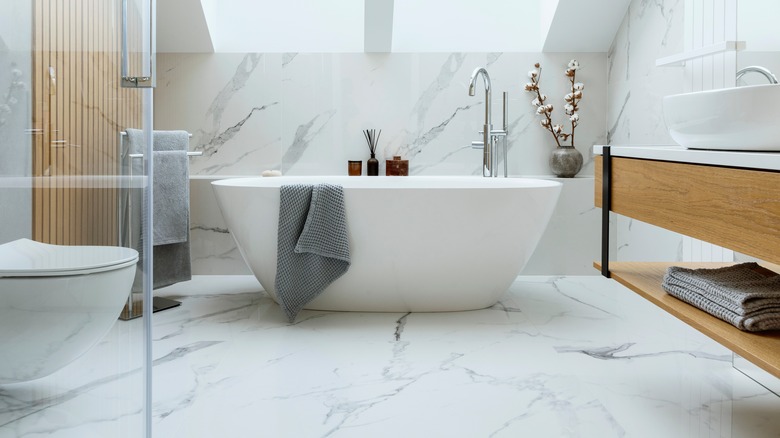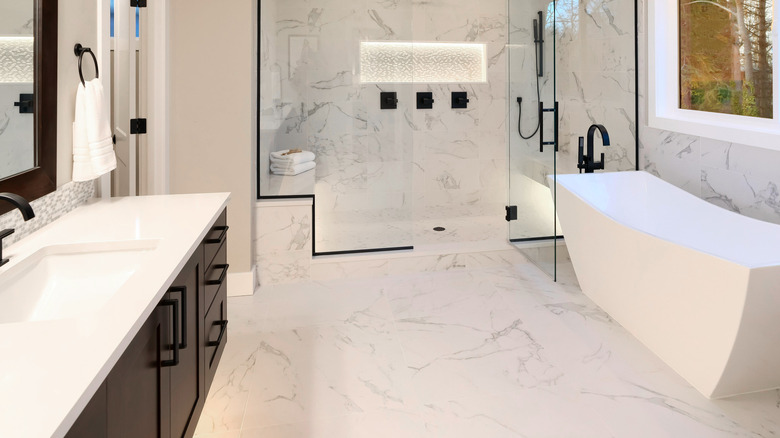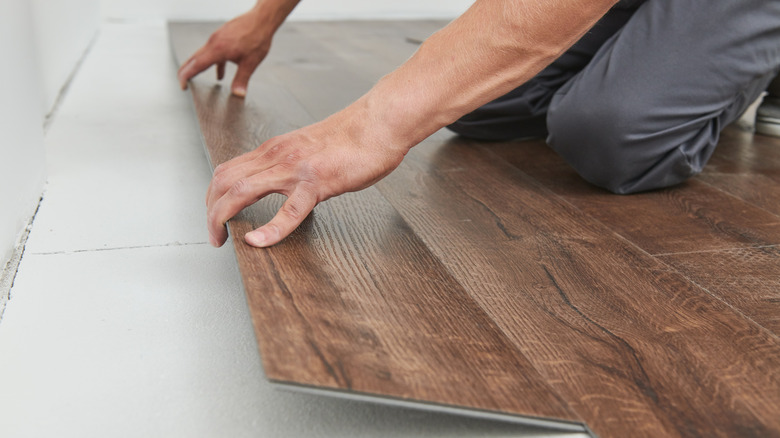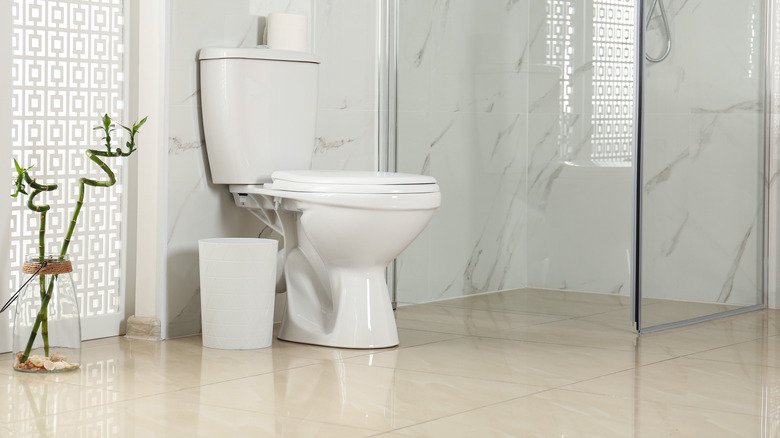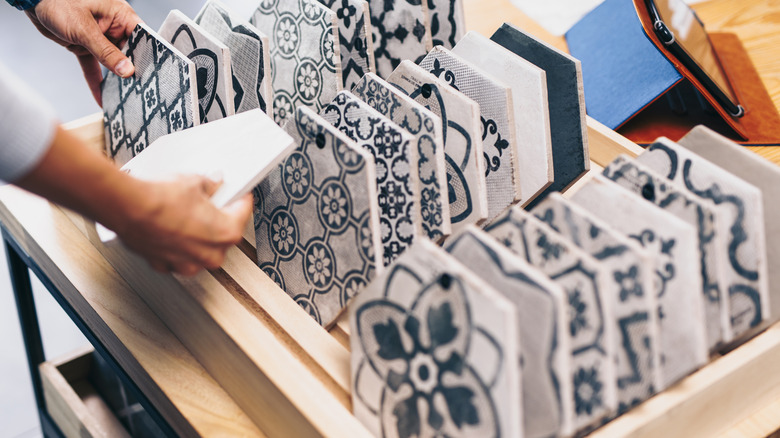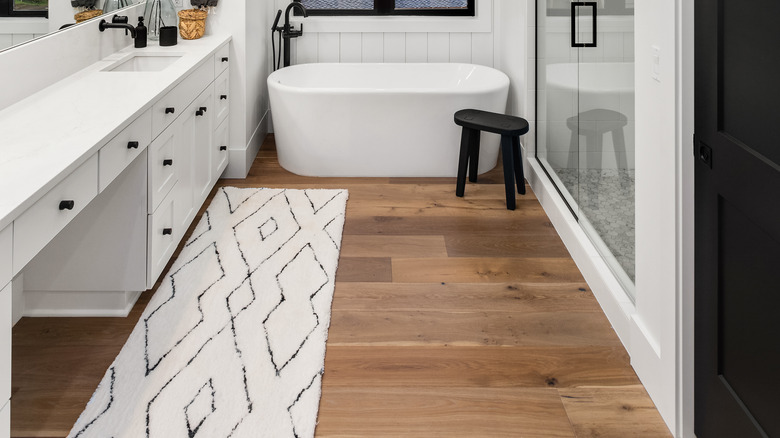The Best Materials For Renovating Your Bathroom Floor
Most people think of a bathroom remodel and instantly imagine enlarging the shower, adding a second sink to the vanity, and creating an oasis they can enjoy at the end of a busy day. Homeowners are also starting to add smart features like interactive LED mirrors, smart showers, and warming drawers to their bathrooms. According to Rocket Morgage, a spa-like bathroom is the most popular remodel project for 2022. But before you can add all the bells and whistles, you need a good base. That means choosing the right type of flooring for your bathroom. While this isn't always an easy feat, there are many options to choose from and some make better bathroom flooring than others.
Bathrooms can experience high traffic, especially in homes with large families. Due to this, and how much water they experience, bathroom floors are subject to wear and tear. You don't want to put a lot of money and effort into new flooring only to have it ruined a short time later. The key to choosing the right bathroom flooring material is considering its durability and waterproof properties. Choosing the right floor covering ensures that your bathroom is not only stylish but also durable.
Natural stone tile
Natural stone encompasses materials like granite, travertine, limestone, and slate. Many homeowners choose these materials because they can visually warm up the space. Stone tiles are available in a range of colors or have details like graining that resemble high-end materials like marble. Natural stone tiles also come in a variety of shapes, with the most popular being square or rectangular, however, you can also find tiles in a chevron or a hexagon shape. All of these aesthetic factors make stone a popular choice.
Natural stone isn't only loved for the beauty it provides but also for its durability. Stone tiles don't show wear and tear, which makes them ideal for a high-traffic area like the bathroom. They are also waterproof, which will protect the material from staining or growing mold or mildew. To maintain the appearance, many natural stone tiles will require sealing, says flooring specialist The Good Guys. Sealing the stone every few years will prevent dirt, debris, and moisture from seeping in and ruining the look.
Vinyl
If you're planning on remodeling your bathroom on a budget, vinyl is a great option for floors. Vinyl often has a bad reputation for being cheap, peeling, and leaving behind a sticky adhesive from tiles that didn't look that great to begin with. But homeowners should remove that idea of vinyl from their minds because the material has come a long way. Vinyl can give bathrooms the appearance of hardwood floors or ceramic tiles at a much lower cost, according to Twenty and Oak. This material is also easy to install, so it is often the best choice for DIY remodels.
Vinyl comes in planks and tiles as well as in a sheet. Vinyl sheets come in rolls that are often twelve or thirteen feet wide and can easily be installed on any prepared subfloor. More modern vinyl planks and tiles have a composite core and can be installed similar to traditional wood floorboards or tiles. Vinyl products come in various styles that mimic the colors and textures of a wide variety of materials.
Porcelain
Many remodel experts will preach about how good porcelain tiles are in the bathroom. Porcelain provides a luxurious look to any room and offers homeowners a variety of stylish options to help create the bathroom of their dreams. White porcelain is one of the most common styles, but you can also find porcelain that resembles wood, has veining like marble or features bold colors and shapes. It's also a great option for the bathroom because you can carry the tiled floor into the shower area for a seamless look.
Porcelain tile can fall on the more expensive side per square foot, with a range of $0.50 to $15, according to Angi, making it a costly installation, even if you complete the renovation yourself. Like the other materials, porcelain is also durable and water-resistant, which makes it ideal for high-traffic, high-moisture areas like the bathroom. However, some porcelain can be slippery with excess water. Remedy this by choosing a porcelain tile with a little bit of texture.
Ceramic tile
When it comes to bathroom tiles, ceramic is one of the most common materials you can find. For many homeowners, ceramic tiles are the go-to material due to the benefits ceramic provides. Ceramic is inexpensive, water-resistant, and durable, ideal for a high-traffic bathroom. Because ceramic is glazed, it has a protective layer that won't let in water and cause stains or cracks. When professionally installed, ceramic floors can last for ten to twenty years, says Tiles Direct, which speaks to the durability of the material.
Ceramic is also great for a homeowner who wants to renovate their bathroom on a budget. The material is incredibly affordable. For the price, you're still able to have a product that offers value to the home over time. Ceramic is also cost-effective because it requires little maintenance after installation. You won't need to do any kind of sealing to preserve the look or integrity of the tile.
Engineered hardwood
The look of hardwood floors is loved throughout the home, and homeowners have been swapping out old carpets for hardwood floors for years. However, there's one place where traditional hardwood isn't great: the bathroom. The excess water from a tub or shower can ruin the integrity of real hardwood floors, warping them and ruining the planks. But if you still like the look of hardwood floors and want to continue it into the bathroom, engineered hardwood is one of the best options.
From the Forest explains that engineered hardwood has real wood veneer over a plywood core, which offers more stability and moisture resistance and helps prevent water damage. However, you still have to keep moisture levels at a minimum to maintain the look of engineered wood floors. You can do this by adding bath mats outside the bathtub or shower and in front of the sink. When showering, keep the ventilation fan running to help some of the steam and moisture escape the room. Lastly, be sure to wipe up any puddles to avoid water sitting on the engineered wood floors for too long.
